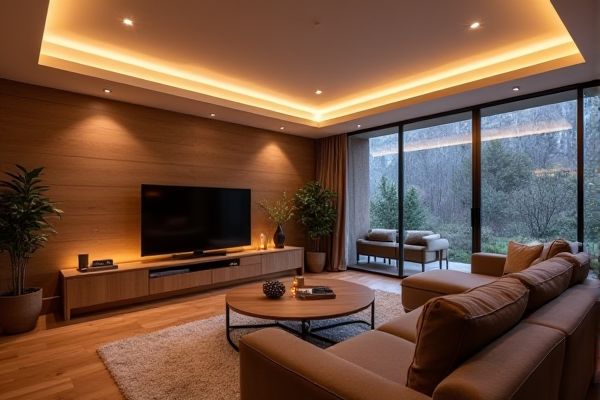
LED strip lighting offers versatile, energy-efficient illumination with customizable colors and easy installation, ideal for accentuating spaces or creating mood lighting. Explore the rest of this article to discover how recessed lighting compares and which option best suits your design and functionality needs.
Table of Comparison
| Feature | LED Strip Lighting | Recessed Lighting |
|---|---|---|
| Installation | Surface-mounted, adhesive backing, easy DIY | Requires ceiling cutouts, professional installation preferred |
| Flexibility | Highly flexible, customizable lengths and colors | Fixed position, limited adjustability |
| Brightness | Moderate brightness, suitable for accent and ambient lighting | High brightness, ideal for general and task lighting |
| Energy Efficiency | Low energy consumption (typically 4-7W/meter) | Energy-efficient LED bulbs (7-15W per fixture) |
| Design | Sleek, modern, enhances architectural features | Minimalist, flush with ceiling for clean look |
| Cost | Affordable, lower initial investment | Higher installation and fixture cost |
| Maintenance | Durable, long lifespan, easy replacement | Long lifespan, bulb replacement more involved |
| Applications | Accent, cove, under-cabinet lighting | General lighting, task lighting in kitchens, offices |
Introduction to LED Strip Lighting and Recessed Lighting
LED strip lighting offers versatile, energy-efficient illumination with flexible design options ideal for accent lighting and creative installations. Recessed lighting provides a sleek, unobtrusive solution that integrates seamlessly into ceilings for ambient or task lighting in residential and commercial spaces. Both lighting types utilize LED technology to enhance energy savings, long lifespan, and customizable color temperature.
Design Flexibility and Aesthetic Appeal
LED strip lighting offers exceptional design flexibility with its ability to be cut to custom lengths and installed in tight or curved spaces, creating continuous lines of light that enhance architectural features and ambiance. Recessed lighting provides a sleek, minimalist aesthetic by integrating fixtures seamlessly into ceilings or walls, ensuring unobtrusive light sources that complement modern interior designs. Both lighting types deliver tailored lighting solutions, with LED strips favoring dynamic, creative applications and recessed lighting emphasizing clean, streamlined elegance.
Installation Process and Complexity
LED strip lighting offers a straightforward installation process with adhesive backing that simplifies mounting on various surfaces, requiring minimal tools and expertise. Recessed lighting demands more complex installation, including cutting ceiling holes, wiring, and securing fixtures, often requiring professional electrical work to meet safety codes. Your choice between the two should consider whether you prefer quick DIY setup or a more permanent, integrated lighting solution.
Energy Efficiency and Cost Savings
LED strip lighting offers superior energy efficiency by consuming up to 75% less electricity than traditional recessed lighting, resulting in significant cost savings on your utility bills. Its lower wattage and longer lifespan reduce both replacement frequency and maintenance expenses, making it a budget-friendly lighting solution. Over time, investing in LED strips can provide more substantial financial benefits compared to recessed lighting due to decreased energy consumption and durable performance.
Lighting Quality and Ambiance
LED strip lighting provides customizable color temperatures and dimming options, creating vibrant, dynamic ambiance perfect for accentuating architectural features or setting moods in various spaces. Recessed lighting offers focused, uniform illumination with minimal glare, delivering a clean and modern aesthetic ideal for general or task lighting. Your choice depends on whether you prioritize flexible ambiance or consistent, unobtrusive brightness.
Customization Options for Different Spaces
LED strip lighting offers extensive customization with flexible lengths, color temperatures, and brightness levels, allowing precise adaptation to various room shapes and design themes. Recessed lighting provides a sleek, minimalist look with adjustable trims and beam angles, ideal for creating focused or ambient light in modern interiors. Both options support smart controls and dimming features, enabling tailored lighting environments for residential, commercial, or hospitality spaces.
Durability and Maintenance Requirements
LED strip lighting offers superior durability with flexible, low-profile designs that resist damage from impacts and moisture, making them ideal for various environments. Recessed lighting, while generally sturdy, involves more complex installation and maintenance due to enclosed fixtures and potential access difficulties for bulb replacement. Your choice should consider how ease of upkeep and long-term reliability align with the specific demands of your space.
Use Cases: Residential vs Commercial Applications
LED strip lighting offers versatile applications in residential settings, enhancing accent walls, under-cabinet areas, and cove lighting to create ambiance and energy efficiency. Recessed lighting is favored in commercial environments for its sleek, unobtrusive design that provides uniform, task-oriented illumination ideal for offices, retail spaces, and galleries. Both lighting types cater to specific functional and aesthetic demands, with LED strips emphasizing decorative flexibility and recessed fixtures prioritizing streamlined, professional lighting solutions.
Smart Home Integration Capabilities
LED strip lighting offers versatile Smart Home integration, allowing you to customize colors, brightness, and schedules through apps and voice assistants like Alexa or Google Home. Recessed lighting can also support smart controls but often requires compatible fixtures and hubs for automation, typically focusing on on/off and dimming functions rather than full color customization. For seamless Smart Home connectivity, LED strip lighting provides greater flexibility and enhanced user personalization options.
Choosing the Right Lighting Solution for Your Needs
LED strip lighting offers flexible, energy-efficient illumination ideal for accentuating architectural features and creating customizable ambiance, making it perfect for cove lighting and under-cabinet applications. Recessed lighting is better suited for providing clean, unobtrusive general or task lighting with a modern, streamlined look in living rooms, kitchens, and hallways. Selecting the right lighting solution depends on your space requirements, desired visual effect, energy consumption goals, and installation preferences.
 homyna.com
homyna.com